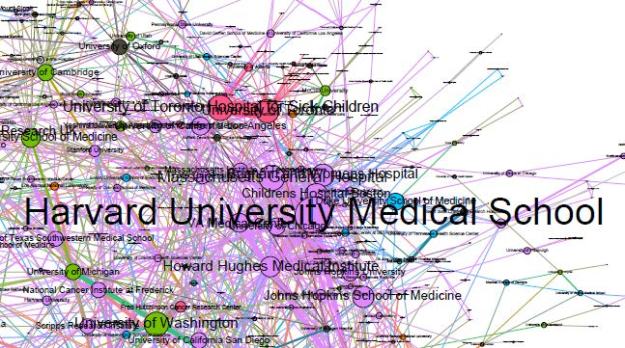Post by Miguel Garcia-Sancho, Principal Investigator of the TRANSGENE project and lead investigator of the human genome strand.
In April, I travelled to Toronto, Canada, to conduct historical research into one of the less well-known facets of early human genome research. The reason for visiting Toronto was that the Hospital for Sick Children features as one of the most densely connected institutions in the network visualisations that the TRANSGENE team is now analysing. These visualisations reflect co-authorship relations in articles that describe for the first time new human, pig and yeast DNA sequences in the scientific literature. Finding a Canadian institution in such a prominent role was somehow a surprise. i later found that a collaboration between Francis Collins – who would later become Director of the Human Genome Project in the US – and researchers at the Hospital for Sick Children resulted in the description of the cystic fibrosis gene in 1989.

A fragment of the co-authorship network displaying the University of Toronto Hospital for Sick Children (upper-right corner)
During my visit to Toronto, I interviewed two scientists heavily involved in the cystic fibrosis story: Johanna Rommens and Stephen Scherer. Both of them were young at the time the gene was described and witnessed the events that followed the 1989 Science publication. A striking characteristic of the co-authorship networks was that collaboration between the University of Michigan – where Collins was based during the cystic fibrosis work – and the Hospital for Sick Children did not seem quantitatively relevant during the 1990s. Rommens and Scherer accounted for this by explaining that Collins shifted his interests to other genes and the Hospital became involved in the mapping and sequencing of human chromosome 7.
Scherer, a student during the cystic fibrosis discovery, undertook a leading role in the chromosome collaboration and forged an alliance with Craig Venter, the CEO of Celera Genomics, who was then seeking the involvement of teaching hospitals in his quest to sequence the whole human genome. In 2003, an article describing the full sequence of chromosome 7 was published in Science under the lead authorship of Scherer, and contributions from Venter and other researchers from Celera, the Massachusetts General Hospital and the John Radcliffe Hospital in Oxford, among others. Unlike the publications from the public and charity-funded Human Genome Sequencing Consortium, the article by Scherer and colleagues focused on the variability in the chromosome sequence and its connection to different hereditary diseases.
The oral histories were combined with work at the archives. I explored more than 800 records, among them the annual reports of the Hospital’s Research Institute and Department of Genetics, as well as the Papers and Correspondence of Lap-Chee Tsui, a Taiwan-born researcher who led the cystic fibrosis group. The archival materials also included funding applications, reviews of the different research units at the Hospital and oral histories with retired staff, mainly the former head of the Genetics Department, Manuel Buchwald. These records, along with the oral histories, will be fed into the further analysis of the co-authorship networks, in order to obtain insights from the combination of quantitative and qualitative evidence.

Miguel Garcia-Sancho at the Archive of the Hospital for Sick Children (Toronto).
